Fort Constitution
From Colonial times through World War II to the present day, Fort Point has played a strategic role in the defense of Piscataqua River and Portsmouth harbor. The area was first fortified by the British prior to 1632, when they erected a fort, which was originally known as "The Castle", situated on the island of New Castle, at the mouth of the Piscataqua River. The fort guarded access to the harbor at Portsmouth and served as the colony's main munitions depot. It was renamed Fort William and Mary circa 1692. In 1774 Fort William and Mary was the only permanently manned military post in New Hampshire. During this year the political strains between the British government and the American colonies intensified. On December 14th, 1774, local Patriots from the Portsmouth area seized the garrison's powder, which was distributed through several New Hampshire towns for potential use in the looming struggle against Great Britain. The next day, these patriots again raided the fort, this time seizing numerous cannons. Following these events, rumors flew around Massachusetts, that troops from Boston were headed to reinforce Fort William and Mary and seize its powder and arms. In 1775 Britain finally gave up on the colony of New Hampshire in order to focus attention on the military situation in Massachusetts and abandoned the fort, removing its remaining equipment to Boston. Following the Revolution the fort was called Castle Fort or Fort Castle.
In 1800, the fort was rebuilt under the Second System of
US fortifications, naming it Fort Constitution. Walls were doubled in height
and new brick buildings added. Work was completed in 1808. During the War of
1812 the guns of Fort Constitution protected Portsmouth Harbor from a British
naval attack. To strengthen the defenses during this conflict a new
fortification in the form of a Martello Tower, named Walbach Tower, was built
in 1814. Round towers built on Corsica during the 1500s, armed with canons,
inspired the design of these circular fortresses. Thr British adapted this
design and named it Martello Tower, after one of the corsican towers built at
Mortella Point. Over a hundred of these Martellos guarded the English and Irish
coastlines during the Napoleonic Wars. Several of these towers were built along
the atlantic coast during the War of 1812. The american examples had three
casemates for smaller guns and a big naval canon mounted in a swivel mount on
the roof.
During the Civil War, Fort Constitution was projected to
be rebuilt as a three-tier granite fort under the Third System of US
fortifications. However, advances in weaponry, particularly armored,
steam-powered warships with heavy rifled guns, rendered the masonry design
obsolete before it was finished. The fort's construction was abandoned in 1867
with the Second System fort largely intact and two walls from the Third System
built around parts of it. In 1897 construction began on Battery Farnsworth,
located under the hill on which the ruins of Walbach Tower stand, as part of
the large-scale Endicott Program of seacoast fortifications. The battery was
accompanied in 1904 by Battery Hackleman. After the American entry into World
War I in early 1917, many guns of Fort Constitution were removed for use at the
Western Front and were not returned to the fort. In 1920 a mine casemate was
built next to Battery Farnsworth to replace a similar facility at Fort Stark.
After World War II the fort was finally disarmed and turned over to the Coast
Guard. Battery Hackleman was demolished, but Battery Farnsworth can still be
seen. In 1973, Fort Constitution State Park was listed on the National Register
of Historic Places and is open to the public today.






Comments
Post a Comment